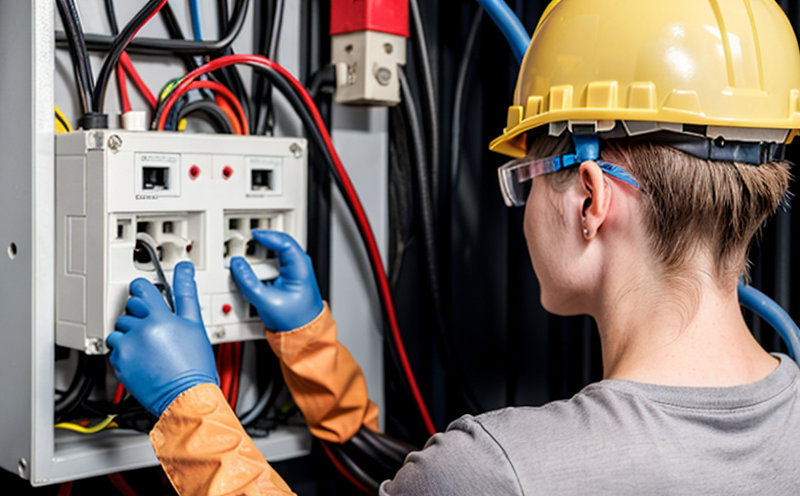CSA E60335 Smart Electrical Device Household Safety Testing
The CSA E60335 standard is an essential requirement for ensuring the safety of smart electrical devices intended for household use. This certification guarantees that products meet stringent safety standards and are free from defects that could cause harm to users or property damage.
The primary focus areas include:
- Electrical insulation integrity
- Overload protection mechanisms
- Grounding and bonding requirements
- Labeling and instructions for use
- Mechanical strength of components
- Flammability resistance
The testing protocol involves a series of rigorous procedures aimed at identifying potential hazards associated with the operation, installation, and use of smart devices. These tests are conducted under controlled laboratory conditions to simulate real-world scenarios where malfunctions or misuse could occur.
One critical aspect is the evaluation of electrical insulation integrity. This ensures that there are no breaches in the insulation material which could lead to electric shocks or fires if left unchecked. The standard also mandates the presence of adequate overload protection, such as circuit breakers and fuses, to prevent overheating and subsequent failures.
Grounding and bonding requirements play a significant role in minimizing risks related to electrical malfunctions by providing an effective path for fault currents to flow safely away from live parts. Proper labeling and instructions for use ensure that consumers understand how to operate the device correctly, reducing the likelihood of misuse leading to accidents.
In terms of mechanical strength, it is crucial that all components can withstand typical stresses without compromising their functionality or safety. Flammability resistance tests aim at verifying whether materials used in construction will ignite easily when exposed to heat sources like open flames or sparks.
The process begins with thorough inspection and documentation of the product's design, manufacturing processes, and intended use case. From there, samples are prepared according to specified dimensions and configurations before undergoing various tests individually or collectively based on identified risks.
Instrumentation plays a vital role in accurately measuring variables such as voltage levels, current consumption patterns, temperature changes during operation cycles, etc., allowing analysts to pinpoint any deviations from expected behavior indicative of latent defects. Reporting involves compiling comprehensive reports detailing findings alongside recommendations for necessary modifications if issues are discovered.
This stringent approach not only protects end-users but also builds consumer trust in smart home products by ensuring they meet rigorous safety standards set forth by reputable organizations like CSA. By adhering to these guidelines, manufacturers demonstrate their commitment to producing reliable, safe electronics that contribute positively to both individual health and overall environmental sustainability goals.
Benefits
Obtaining the CSA E60335 certification brings numerous advantages for manufacturers and distributors of smart electrical devices:
- Increased market access: Meeting this standard opens up opportunities to sell products internationally, particularly in North America where it enjoys widespread recognition.
- Enhanced reputation: Consumers increasingly seek out trustworthy brands that prioritize safety above all else. Earning this certification enhances brand image and fosters long-term customer loyalty.
- Improved product reliability: Stringent testing helps identify weak points early on, allowing manufacturers to address them proactively rather than reactively after incidents occur.
- Competitive advantage: Offering safer products can give companies an edge over competitors who may not invest in similar rigorous quality assurance measures.
- Potential cost savings: Early detection of flaws through comprehensive testing reduces the need for costly recalls later down the line, thereby lowering operational expenses.
In summary, compliance with the CSA E60335 standard ensures that your smart electrical devices meet internationally recognized safety benchmarks, providing peace of mind to both consumers and stakeholders alike while fostering trust within competitive markets.
Eurolab Advantages
At Eurolab, we pride ourselves on offering unparalleled expertise in CSA E60335 smart electrical device household safety testing. Our team of highly skilled professionals combines deep technical knowledge with hands-on experience to ensure accurate and reliable results every time.
- State-of-the-art facilities: Equipped with advanced equipment capable of simulating diverse environmental conditions, our labs provide realistic test scenarios that closely mirror real-world situations.
- Dedicated resources: We allocate specialized personnel trained specifically in performing the required tests according to current best practices and international standards.
- Comprehensive support: From initial consultation through final certification issuance, our team offers continuous guidance tailored to meet your unique needs throughout the entire process.
- Prompt turnaround times: Leveraging efficient workflows and streamlined procedures allows us to deliver results quickly without compromising on quality.
We understand that time is money, especially for busy professionals responsible for overseeing product development cycles. That's why we strive to minimize disruptions while ensuring optimal outcomes. By choosing Eurolab for your CSA E60335 testing requirements, you can rest assured knowing you're working with industry leaders committed to excellence.
Environmental and Sustainability Contributions
Besides enhancing safety, adhering to the CSA E60335 standard has significant environmental benefits:
- Promotes resource efficiency: By identifying and addressing inefficiencies early in the design phase, manufacturers can reduce material waste and energy consumption throughout production processes.
- Ease of recycling: Products designed to meet these stringent safety criteria often incorporate materials that are easier to recycle at end-of-life, minimizing landfill contributions.
- Reduces emissions: Safer devices contribute indirectly by promoting correct usage patterns among consumers, reducing the frequency and intensity of repair or replacement needs which might otherwise lead to increased energy consumption.
- Promotes sustainable innovation: The focus on robust design principles encourages ongoing advancements in technology aimed at enhancing both performance and sustainability simultaneously.
Incorporating these practices into everyday operations helps create a more sustainable future by fostering responsible manufacturing habits that prioritize long-term impact over short-term gains. Eurolab's commitment extends beyond just testing; we actively participate in initiatives promoting global environmental stewardship through education, collaboration, and continuous improvement.





